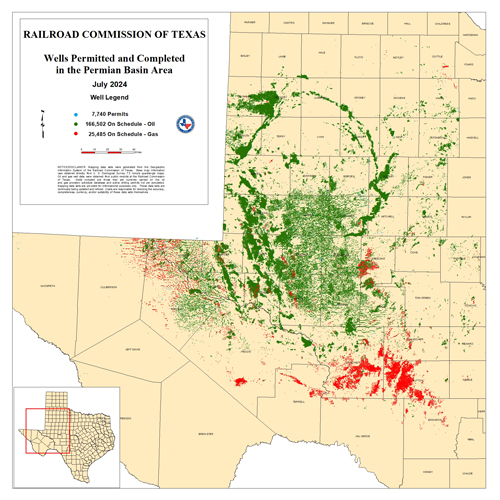Permian Basin
Information & Statistics
What is the Permian Basin?
The Permian Basin is an oil-and-gas-producing area located in West Texas and the adjoining area of southeastern New Mexico. The Permian Basin covers an area approximately 250 miles wide and 300 miles long and is composed of more than 7,000 fields (best represented in Railroad Commission of Texas production figures as districts 7C, 08, and 8A) in West Texas. Various producing formations such as the Yates, San Andres, Clear Fork, Spraberry, Wolfcamp, Yeso, Bone Spring, Avalon, Canyon, Morrow, Devonian, and Ellenberger are all part of the Permian Basin, with oil and natural gas production depths ranging from a few hundred feet to five miles below the surface. Other areas within the greater Permian Basin include the Delaware Basin and Midland Basin. The Delaware Basin includes significant development in the Bone Spring and Wolfcamp, together known as the Wolfbone. The Midland Basin includes significant development in the Spraberry and Wolfcamp, together known as the Wolfberry. Recent increased use of enhanced-recovery practices in the Permian Basin has resulted in a substantial impact on U.S. oil production.
Because of the Permian Basin, Texas not only receives an enormous economic benefit but also helps provide energy security for the country. The greater Permian Basin accounts for nearly 40 percent of all oil production in the United States and nearly 15 percent of its natural gas production, according to the Federal Reserve Bank of Dallas. And there’s significant potential growth simply from the Delaware Basin. In 2018, the U.S. Geological Survey estimated that the Delaware Basin in West Texas and Southern New Mexico has the potential to produce 46.3 billion barrels of oil and the potential to produce 281 trillion cubic feet of natural gas.
Disclaimer: This data is a snapshot in time displaying production data from the RRC’s Production Data Query System (PDQ) based on the extract date.
Statistics
- Permian Basin 2008 To Current
- Permian Basin 2022
- Permian Basin 2021
- Permian Basin 2020
- Permian Basin 2019
- Permian Basin 2018
- Permian Basin 2017
- Permian Basin 2016
- Permian Basin 2015
- Permian Basin 2014
- Permian Basin 2013
- Permian Basin 2012
- Permian Basin 2011
- Permian Basin 2010
- Permian Basin 2009
- Permian Basin 2008








